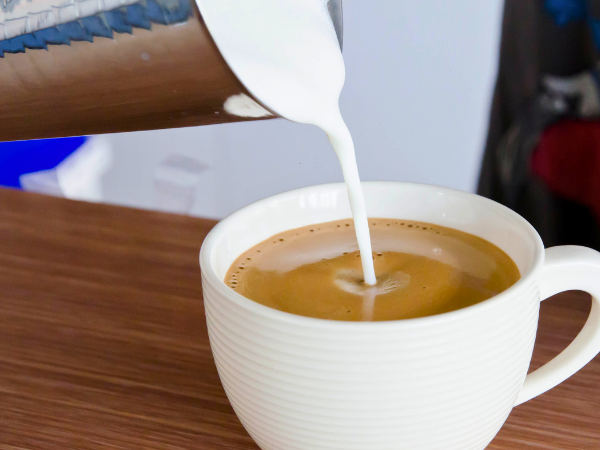Cappuccino coffee is a popular Italian espresso-based drink. It combines equal parts of espresso, steamed milk, and milk froth.
With its creamy froth and robust espresso foundation, cappuccino offers a perfect balance for those seeking a medium-strength coffee. For coffee shops and aficionados alike, mastering the art of cappuccino preparation is a testament to their dedication to the craft of coffee making.
Cappuccino Origins
Let’s explore the fascinating origins of this classic beverage, diving into its Italian heritage and uncovering how it became a global sensation.
Italian Heritage
The cappuccino journey starts in the early 20th century, amidst the bustling cafes of Italy. The name itself is inspired by the Capuchin friars, referencing the color of their robes. This iconic coffee owes its popularity to the Italian tradition of espresso making and the artistry of baristas.
- Espresso: The foundation of every cappuccino, a strong shot of espresso is crucial for the deep, robust flavor.
- Steamed Milk: Adds smoothness and body, tempering the espresso’s intensity.
- Milk Foam: The crowning glory, a thick layer of airy foam captures the essence of a classic cappuccino.
Difference In Cappuccino And Coffee
Many coffee lovers eagerly savor the rich taste of a cappuccino, but often wonder how it differs from regular coffee.
The Core Components Of A Cappuccino
The cappuccino boasts a precise balance of ingredients. Espresso forms the strong coffee base, steamed milk adds creaminess, and a layer of milk froth offers a light, airy touch. This trio distinguishes a cappuccino from other coffee drinks.
Cappuccino Versus Regular Coffee: The Breakdown
Let’s break down the elements that set cappuccino apart from regular coffee:
- Preparation: Cappuccino is an espresso-based drink, unlike regular coffee, which is typically brewed.
- Texture: The velvety froth atop a cappuccino is absent in regular coffee.
- Milk Ratio: Cappuccinos have equal parts of espresso, steamed milk, and froth, a balance not found in other coffees.
Visual And Taste Profile: Cappuccino Vs. Coffee
A cappuccino is not only distinct in taste but also in appearance. The layered look is iconic, with its dark bottom, white middle, and light brown top. In contrast, regular coffee has a uniform color. Taste-wise, a cappuccino offers a rich and bold flavor with a smooth texture, while regular coffee has a more straightforward taste and thinner consistency.
The Cultural Aspect Of Drinking Cappuccino
Drinking a cappuccino goes beyond taste; it’s a cultural experience. In Italy, cappuccinos are morning beverages, rarely consumed after 11 a.m. In contrast, regular coffee is an all-day drink in many cultures. This ritual adds a special charm to enjoying a cappuccino, making it not just a coffee, but a part of a lifestyle.
The Fastest Way To Cook Cappuccino Homemade
Making cappuccino at home is easy, fast, and can be just as delicious as the ones served in cafes. Let’s dive into the quickest way to craft a homemade cappuccino.

The Fastest Way to Cook Cappuccino
Equipment
- Espresso machine or Moka pot
- Milk frother or steam wand
- Coffee grinder (if using whole beans)
- Measuring spoon
- Mug
Ingredients
- 2 shots Espresso beans
- 2 ounces Filtered water
- 1 cup Milk
- Sugar or sweetener
Instructions
Heat The Milk
- Begin by heating your milk. Pour milk into a saucepan and place it on medium heat. Stir occasionally to prevent a skin from forming. Heat it until it's hot but not boiling. If you have a thermometer, aim for around 150°F (65°C) for the perfect temperature. Remember, scalded milk can ruin the taste.

Brew The Espresso Shot
- While the milk is heating, grind your espresso beans to a fine consistency. Pack the grounds into your espresso machine's portafilter. Press down firmly to ensure a smooth, even shot. Start your machine and brew a single or double shot, depending on your preference. A good shot of espresso is the foundation of a great cappuccino.

Froth The Milk To Perfection
- Once your milk is heated, it's time to froth. If you have a frother, submerge it into the warm milk and turn it on. Move it around until the milk is frothy and has doubled in volume. No frother? No problem. A whisk or even a shake in a tightly sealed jar can do the trick. Aim for a thick, creamy foam to top off your cappuccino.

Pour And Combine Espresso With Milk
- With your two espresso shots ready and your milk frothed, it’s time to combine the elements. First, pour one shot of espresso into each warm cup. Next, gently pour about 1/2 cup (120 ml) of hot frothed milk into each cup, holding back the foam with a spoon. Finally, spoon the frothy milk foam on top to finish. The ideal ratio is 1/3 espresso, 1/3 hot milk, and 1/3 foam, creating those classic cappuccino layers.

Add Toppings For Extra Flavor
- For a final touch, add toppings to your cappuccino. Sprinkle a dash of cinnamon, nutmeg, or cocoa powder over the foam. Some might enjoy a drizzle of caramel or chocolate sauce. These little additions can turn your homemade cappuccino into a gourmet treat.

Ingredients Breakdown
Let’s dive into the Ingredients Breakdown to understand what makes a cappuccino so special.
Espresso Base
The foundation of every cappuccino is a strong espresso base. Espresso is a concentrated coffee brewed by forcing hot water through finely-ground coffee beans. This process creates a thick, rich liquid topped with a creamy foam called crema. Here’s what you need to know about the espresso in a cappuccino:
- Bean Quality: The beans should be high-quality, often a blend of Arabica and Robusta.
- Grind Size: A fine grind is essential for the perfect espresso extraction.
- Brewing Technique: Expert baristas ensure the right temperature and pressure.
| Espresso Aspect | Details |
|---|---|
| Bean Origin | Varies, often a mix of different regions |
| Grind Consistency | Uniform and fine |
| Extraction Time | 25-30 seconds typically |
Steamed Milk
Steamed milk adds a creamy texture and balances the strong espresso. It’s made by heating milk with steam to create a smooth and velvety consistency. Here’s what goes into steaming milk for a cappuccino:
- Milk Type: Whole milk is preferred for the best foam, but alternatives can be used.
- Temperature: Around 150°F is ideal for sweetness and warmth without scalding.
- Technique: Baristas aim for microfoam, tiny bubbles that make the milk glossy.
| Milk Aspect | Details |
|---|---|
| Milk Fat Content | Higher fat content creates richer foam |
| Steam Wand Use | Should immerse just below the surface to incorporate air |
| Frothing Pitcher | Stainless steel preferred for temperature control |
Foamed Milk
The crown of the cappuccino is the foamed milk. It’s airy, light, and holds the warmth of the drink. Achieving the perfect foam requires skill. Below are details about creating foamed milk:
- Air Incorporation: Just the right amount of air creates the perfect froth.
- Volume Increase: Good foam can double the volume of the milk.
- Texture: The goal is a smooth and consistent layer of microfoam.
| Foam Aspect | Details |
|---|---|
| Whisking Speed | Fast at the start, then slow to finish |
| Temperature Control | Not too hot to avoid scalding the foam |
| Serving Time | Serve immediately to maintain structure |

Quantity Caffeine In A Cappuccino
For many, its caffeine content is just as important as its taste. Let’s dive into the details of how much caffeine you’ll find in a cappuccino.
Espresso: The Caffeine Source
Espresso, the foundation of a cappuccino, is where all the caffeine comes from. Typically, one shot of espresso contains about 63 milligrams of caffeine. Most cappuccinos use a single shot, making the caffeine content fairly consistent.
Cappuccino Caffeine Content
A standard cappuccino serving size is about 6 ounces with a single shot of espresso. This means that a cappuccino generally has around 63 milligrams of caffeine. The size of the drink and the number of espresso shots can vary, so the caffeine content can range from 63 to 126 milligrams if a double shot is used.
Factors Affecting Caffeine Levels
Several factors can influence the caffeine content in your cappuccino:
| Factor | Impact on Caffeine |
|---|---|
| Espresso Shot Volume | More volume, more caffeine |
| Bean Type | Robusta has more caffeine than Arabica |
| Grind Size | Finer grinds can extract more caffeine |
Understanding these factors can help you customize your cappuccino to your preferred caffeine level.
Quantity Milk In A Cappuccino
A key component that defines a cappuccino’s character is the quantity of milk used. Let’s dive into how much milk goes into a cappuccino and why it matters.
Understanding The Milk Ratio In A Cappuccino
The magic of a cappuccino lies in its layers. Traditionally, it consists of equal parts espresso, steamed milk, and milk foam. This three-layer structure creates a harmony of flavors and textures. But, what’s crucial is the quantity of milk. It determines the drink’s thickness, taste, and temperature.
How Much Milk Goes Into A Cappuccino?
A standard cappuccino usually contains about 150-180 ml of milk. This includes both the steamed milk and the frothy top layer. To break it down:
- 75-90 ml of steamed milk
- 75-90 ml of milk foam
This balance ensures the cappuccino is creamy yet not too heavy.
Why Does The Milk Quantity Matter?
The amount of milk is crucial for a few reasons:
- It affects the flavor balance between the espresso and milk.
- It determines the texture of the drink.
- A proper ratio ensures the right temperature of the cappuccino.
Getting the milk quantity right is essential for the perfect cappuccino experience.
How Many Calories In A Cappuccino
Many wonder about the calories in a cappuccino. Let’s dive in and find out.
Basic Cappuccino Calories
A simple cappuccino has three main parts: espresso, steamed milk, and foam. A regular-sized cappuccino usually has about 85 calories. This is for one made with whole milk.
Impact Of Milk Choice On Calories
The type of milk used changes the calorie count. Here’s a quick look:
| Milk Type | Calories in a Regular Cappuccino |
|---|---|
| Whole Milk | 85 calories |
| Skim Milk | 70 calories |
| Almond Milk | 50 calories |
Added Sugars And Their Effects
Adding sugar increases calories. For example, one teaspoon of sugar adds about 16 calories. So, it’s important to consider this if you’re watching your calorie intake.
Calorie Cutting Tips For Cappuccino Lovers
- Use low-fat or plant-based milk to reduce calories.
- Avoid adding extra sugar. Try natural sweeteners like stevia.
- Opt for a smaller size to keep calories in check.

